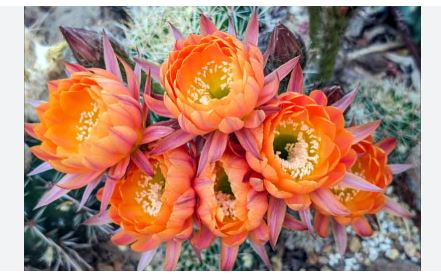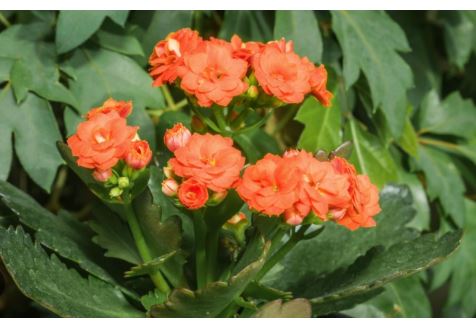
Cactus plants with orange flowers bring a vibrant burst of color to any garden or indoor space. Their striking blooms, ranging from soft peach to fiery tangerine, contrast beautifully with their spiny, sculptural forms. These cacti are perfect for enthusiasts seeking low-maintenance plants with high visual impact, thriving in arid conditions where other plants might struggle.
The orange flowers of these cacti often appear in spring or summer, creating a stunning display that can last days or weeks. The blooms vary in shape, from funnel-like to star-shaped, and are often large relative to the plant’s size. This vivid coloration attracts pollinators like bees and hummingbirds, adding ecological value to their aesthetic appeal.
Caring for these cacti is straightforward, making them ideal for beginners. They require bright, direct sunlight for at least six hours daily and well-draining soil to prevent root rot. Watering should be sparse, allowing the soil to dry completely between sessions, especially in winter when the plants are dormant.
Propagation is another appealing aspect, as many of these cacti produce offsets or can be grown from cuttings or seeds. This allows collectors to expand their displays or share with others. Their compact size also makes them suitable for small spaces like windowsills or terrariums.

Why Choose Cacti With Orange Flowers?
Orange flowers symbolize enthusiasm, creativity, and warmth, making them a perfect choice for adding a pop of color to your space. Cacti with orange blooms are especially appealing because they combine the low-maintenance nature of succulents with the visual impact of vivid flowers. These plants are ideal for:
- Beginner gardeners: Cacti are hardy and forgiving, requiring minimal care.
- Small spaces: Many of these species are compact, perfect for windowsills or terrariums.
- Desert-inspired aesthetics: Orange flowers complement the earthy tones of arid landscapes.
- Seasonal interest: Their blooms, though often short-lived, create a spectacular display.
Echinopsis chamaecereus (Peanut Cactus)
The Peanut Cactus is a small, clustering cactus with finger-like stems that resemble peanuts. Native to Argentina, this cactus produces vibrant orange flowers in late spring to early summer.
- Appearance: Short, cylindrical stems grow in dense clusters, with soft spines and bright orange, funnel-shaped flowers.
- Size: Up to 6 inches tall, spreading up to 12 inches wide.
- Care: Prefers bright, indirect light and well-draining soil. Water sparingly, allowing the soil to dry out completely between waterings.
- Blooming Season: Spring to early summer.
- Why Grow It?: Its compact size and prolific orange blooms make it ideal for small pots or rock gardens.
Rebutia muscula (Orange Snowball)
The Orange Snowball is a small, globular cactus from Bolivia that forms dense clumps over time. Its bright orange flowers contrast beautifully with its green body and white spines.
- Appearance: Spherical, with soft white spines and vivid orange flowers that can cover the entire plant.
- Size: 2–3 inches in diameter, forming clusters up to 10 inches wide.
- Care: Thrives in full sun with gritty, well-draining soil. Water moderately in spring and summer, reduce in winter.
- Blooming Season: Late spring to early summer.
- Why Grow It?: Its prolific flowering and compact size make it a favorite for collectors.
Echinocereus triglochidiatus (Claret Cup Cactus)
The Claret Cup Cactus, native to the southwestern United States and northern Mexico, is a standout with its brilliant orange-red flowers that attract hummingbirds.
- Appearance: Cylindrical or mound-forming stems with dense spines and cup-shaped, orange-red flowers.
- Size: Up to 12 inches tall and 18 inches wide.
- Care: Requires full sun and sandy, well-draining soil. Water sparingly, especially in winter.
- Blooming Season: Late spring to early summer.
- Why Grow It?: Its vibrant flowers and wildlife-friendly nature make it a great choice for xeriscapes.
Mammillaria spinosissima (Red-Headed Irishman)
While often associated with red or pink flowers, some varieties of Mammillaria spinosissima produce orange blooms, especially in hybrid forms.
- Appearance: Cylindrical stems with white spines and a crown of orange flowers.
- Size: Up to 12 inches tall and 4 inches wide.
- Care: Prefers bright light and well-draining soil. Water moderately during the growing season.
- Blooming Season: Spring.
- Why Grow It?: Its unique spiny texture and colorful blooms add character to any collection.
Rebutia heliosa (Sunrise Cactus)
The Sunrise Cactus is a Bolivian native known for its profusion of orange flowers that create a glowing effect against its small, spiny body.
- Appearance: Small, globular stems with fine spines and bright orange, star-shaped flowers.
- Size: 2–4 inches tall, forming clumps up to 8 inches wide.
- Care: Needs bright light and well-draining soil. Water sparingly, ensuring the soil dries out between waterings.
- Blooming Season: Late spring to early summer.
- Why Grow It?: Its compact size and abundant blooms make it a showstopper in small spaces.
Echinopsis hybrida (Hybrid Torch Cactus)
Hybrid Torch Cacti are bred for their spectacular flowers, and many produce stunning orange blooms. These hybrids are derived from species like Echinopsis chamaecereus and Echinopsis lobivia.
- Appearance: Varies by hybrid, but often features ribbed, columnar stems with large, trumpet-shaped orange flowers.
- Size: 6–12 inches tall, depending on the hybrid.
- Care: Requires full sun and well-draining soil. Water moderately in spring and summer.
- Blooming Season: Spring to summer.
- Why Grow It?: The large, vibrant flowers are perfect for adding drama to your collection.
Lobivia aurea (Golden Barrel Cactus)
While the Golden Barrel Cactus is better known for its yellow flowers, certain varieties produce orange blooms, especially in hybrid forms.
- Appearance: Spherical or slightly elongated stems with golden spines and orange flowers.
- Size: Up to 8 inches tall and wide.
- Care: Needs full sun and gritty soil. Water sparingly, especially in winter.
- Blooming Season: Late spring to summer.
- Why Grow It?: Its striking form and colorful blooms make it a focal point in any garden.
Ferocactus wislizeni (Fishhook Barrel Cactus)
The Fishhook Barrel Cactus, native to the southwestern U.S. and Mexico, produces orange to reddish-orange flowers that add a warm glow to its spiny body.
- Appearance: Large, barrel-shaped stems with hooked spines and orange flowers.
- Size: Up to 3 feet tall and 2 feet wide.
- Care: Thrives in full sun and sandy soil. Water infrequently, allowing the soil to dry out completely.
- Blooming Season: Late summer to early fall.
- Why Grow It?: Its impressive size and vibrant flowers make it ideal for desert landscapes.
Rebutia fiebrigii (Orange Crown Cactus)
The Orange Crown Cactus is a small, clustering cactus from Bolivia with bright orange flowers that form a crown-like ring around the plant.
- Appearance: Globular stems with short spines and orange, funnel-shaped flowers.
- Size: 3–5 inches tall, forming clumps up to 10 inches wide.
- Care: Prefers bright light and well-draining soil. Water moderately during the growing season.
- Blooming Season: Spring to early summer.
- Why Grow It?: Its compact size and prolific blooms make it perfect for beginners.
Parodia haselbergii (Scarlet Ball Cactus)
The Scarlet Ball Cactus produces orange to reddish-orange flowers, creating a striking contrast against its woolly, white-spined body.
- Appearance: Small, spherical stems with white, woolly spines and orange flowers.
- Size: 3–5 inches in diameter.
- Care: Needs bright light and well-draining soil. Water sparingly, especially in winter.
- Blooming Season: Spring.
- Why Grow It?: Its unique texture and vibrant flowers make it a standout in any collection.
Echinocereus pentalophus (Ladyfinger Cactus)
The Ladyfinger Cactus, native to Mexico, produces delicate orange flowers that complement its slender, finger-like stems.
- Appearance: Thin, elongated stems with short spines and orange, tubular flowers.
- Size: Up to 12 inches tall and 18 inches wide.
- Care: Prefers full sun and well-draining soil. Water moderately in spring and summer.
- Blooming Season: Late spring to early summer.
- Why Grow It?: Its graceful form and colorful blooms add elegance to any space.
Gymnocalycium mihanovichii (Moon Cactus)
While Moon Cacti are often grafted and known for their colorful tops, certain varieties produce orange flowers when mature.
- Appearance: Small, colorful stems (often grafted) with orange flowers in some varieties.
- Size: 2–4 inches tall.
- Care: Needs bright, indirect light and well-draining soil. Water sparingly.
- Blooming Season: Summer.
- Why Grow It?: Its vibrant colors and small size make it a popular choice for beginners.
Echinopsis subdenudata (Domino Cactus)
The Domino Cactus occasionally produces orange flowers in certain hybrids, adding a warm touch to its smooth, spineless body.
- Appearance: Globular, spineless stems with large, orange flowers in some varieties.
- Size: 4–6 inches tall and wide.
- Care: Prefers bright light and well-draining soil. Water moderately during the growing season.
- Blooming Season: Spring to summer.
- Why Grow It?: Its smooth texture and occasional orange blooms make it unique.
Aporocactus flagelliformis (Rat Tail Cactus)
The Rat Tail Cactus is a trailing cactus with long, slender stems and vibrant orange flowers, making it ideal for hanging baskets.
- Appearance: Long, rope-like stems with soft spines and orange, tubular flowers.
- Size: Stems can grow up to 3 feet long.
- Care: Needs bright, indirect light and well-draining soil. Water moderately in spring and summer.
- Blooming Season: Spring to early summer.
- Why Grow It?: Its trailing habit and colorful blooms make it perfect for vertical displays.
General Care Tips for Orange-Flowered Cacti
To ensure your orange-flowered cacti thrive and produce their stunning blooms, follow these general care guidelines:
- Light: Most cacti prefer bright, direct sunlight for at least 6 hours daily. A south-facing window or outdoor spot is ideal.
- Soil: Use a well-draining cactus or succulent potting mix, or create your own with sand, perlite, and potting soil.
- Watering: Water deeply but infrequently, allowing the soil to dry out completely between waterings. Reduce watering in winter.
- Temperature: Most cacti prefer warm temperatures (70–90°F during the day) and can tolerate cooler nights (50–60°F).
- Fertilizer: Feed with a diluted cactus fertilizer monthly during the growing season (spring and summer).
- Pests: Watch for pests like mealybugs or spider mites. Treat with insecticidal soap or neem oil if needed.
Propagating Orange-Flowered Cacti
Many of these cacti can be propagated through offsets, cuttings, or seeds:
- Offsets: Species like Rebutia and Echinopsis produce offsets (pups) that can be gently removed and replanted.
- Cuttings: For cacti like Aporocactus flagelliformis, take stem cuttings, let them callous for a few days, and plant in well-draining soil.
- Seeds: Growing from seeds is slower but rewarding. Sow in a cactus mix, keep warm, and maintain light moisture.
Where to Find Orange-Flowered Cacti
You can find these cacti at:
- Local Nurseries: Check for cactus and succulent sections.
- Online Retailers: Websites like Etsy, eBay, or specialized succulent shops often carry rare varieties.
- Cactus Societies: Join local or online cactus clubs for access to unique specimens and propagation materials.
- Garden Centers: Big-box stores like Home Depot or Lowe’s may carry common varieties like Mammillaria or Echinopsis.